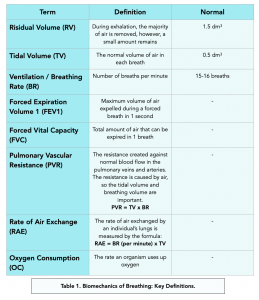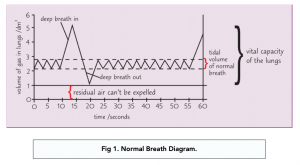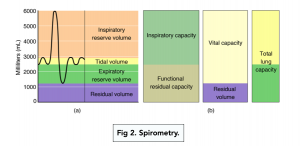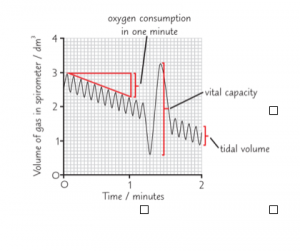Pulmonary Ventilation Rate (A-level Biology)
Pulmonary Ventilation Rate
Physiology of a Normal Lung
Tidal Volume and Ventilation Terms
Tidal volume is the volume of air in a normal breath. The average tidal volume of a healthy young adult is around 0.5 litres (500ml).
Important terms to understand are shown in the table below:

Below is graph showing the amount of gas in the lungs during a normal breath:

Spirometry
Spirometry
- We can use spirometry to measure lung function and investigate breathing. The efficiency of gas exchange in the lungs can be measured through a process known as spirometry.
- Spirometry measures air volumes. Spirometry measures the volume of air that is exchanged between the lungs and the atmosphere. Changes in the amount of air exchanged can happen normally due to physical activity, or abnormally due to various diseases.
- Spirometry is often used in diagnosis. Spirometry is a powerful diagnostic tool for measuring normal activities of the lungs and for diagnosing potential problems. Spirometry can help in the diagnosis of diseases such as asthma.
Information Given by a Spirometer
Breathing rate increases during exercise or physical activity. This means there is an increase in the amount of air exchanged and an increase in PVR.

A spirometer can give information on the following:
- Tidal volume
- Vital capacity
- Breathing rate
- Oxygen uptake
Spirometer Chamber
- Oxygen-filled chamber – a spirometer has an oxygen-filled chamber which is connected to tubes and suspended in a tank of water.
- Moveable lid – the chamber has a moveable lid in order to adjust along with the changes of the volume of gas inside.
- Soda lime – the chamber also has soda lime inside in order to absorb the exhaled carbon dioxide, meaning when the lid moves, it is due to the gas volume changes produced by the oxygen inhaled/exhaled by the person breathing.
- Nose clip – by wearing a nose clip, it ensures all breathing happens through the mouth, where it can be better recorded.
The total volume of gas decreases in the chamber over time due to the air that is being breathed out being a mixture of oxygen and carbon dioxide.
Spirometer Tracing
Obtaining a spirometer trace:
- Start the kymograph (records the tracing) and force a known amount of air into the empty chamber to find the vertical scale.
- Set the speed the drum turns to 1 mm per second using the switch to find the horizontal scale.
- Fill the spirometer with medical grade oxygen.
- Disinfect the mouthpiece and attach it to the tube. By turning the tap, make sure the tube is not attached to the spirometer.
- Subject applies nose clip and breathes into the tube (practice first!). Start the kymograph and turn the tap in order to attach the tube to the spirometer.
- Take one forced breath then breathe normally for a maximum of 5 minutes. As the subject breathes in/out, the chamber side moves up/down, which are recorded on the rotating drum, creating the spirometer tracing.
* A motion sensor can be used instead of a rotating drum – this uses the movements to create electrical signals, picked up by a kymograph.
Analysing Spirometer Data
The following steps will help you work out breathing rate, tidal volume, vital capacity and oxygen consumption from a spirometer trace/spirograph:
- The breathing rate is 10 breaths per minute in the first minute, shown by there being 10 ‘spikes’.
- The tidal volume can change depending on the person, however in this case, it is 0.5 dm3 (the average for a healthy young adult).
- The vital capacity is show to be 2.65 dm3.
- Oxygen consumption is the volume of gas in the spirometer left at the end. It is calculated by taking the average slope of the trace (in this case it is 0.7 dm3/min.

Pulmonary ventilation rate refers to the amount of air that moves in and out of the lungs per minute. This process is also known as breathing and is essential for maintaining a supply of oxygen to the body and removing carbon dioxide.
There are several factors that determine pulmonary ventilation rate, including:
Brainstem control: The rate of breathing is regulated by the brainstem, which sends signals to the muscles involved in breathing.
Oxygen levels: Low levels of oxygen in the blood can stimulate an increase in breathing rate to bring more oxygen into the body.
Carbon dioxide levels: High levels of carbon dioxide in the blood can also stimulate an increase in breathing rate to remove the excess carbon dioxide.
Physical activity: Physical activity can increase breathing rate as the body needs more oxygen to support increased metabolism. Emotional state:
Emotions such as anxiety or stress can also increase breathing rate.
Breathing rate can change in response to different conditions, including:
During exercise: Breathing rate increases during exercise to supply the body with more oxygen and remove excess carbon dioxide produced by increased metabolism.
In sleep: Breathing rate decreases during sleep as the body’s metabolic rate slows down.
In altitude: Breathing rate increases at high altitudes to compensate for the lower levels of oxygen in the air.
In respiratory diseases: Breathing rate can be affected in respiratory diseases such as asthma or chronic obstructive pulmonary disease (COPD), leading to rapid or shallow breathing.
Pulmonary ventilation rate can be measured using a spirometer, which is a device that measures the amount of air inhaled and exhaled per minute. The measurement can also be calculated using the volume of air moved in and out of the lungs and the rate at which it is moved.
Measuring pulmonary ventilation rate is important for several reasons, including:
Diagnosing respiratory diseases: Abnormal breathing patterns can indicate the presence of a respiratory disease, such as asthma or COPD.
Monitoring response to treatment: Measuring pulmonary ventilation rate can help to monitor the response to treatment for respiratory diseases.
Assessing fitness level: Breathing rate can be used to assess an individual’s fitness level and their ability to handle physical activity.
There are several factors that can affect pulmonary ventilation rate, including:
Aging: Breathing rate decreases with age, due in part to changes in the muscles and nervous system involved in breathing.
Obesity: Being overweight or obese can increase breathing rate due to the added effort required to move the larger body mass.
Smoking: Smoking can lead to lung damage and respiratory problems, affecting breathing rate.
Exposure to pollutants: Exposure to pollutants such as tobacco smoke or air pollution can cause respiratory problems and affect breathing rate.






Still got a question? Leave a comment
Leave a comment